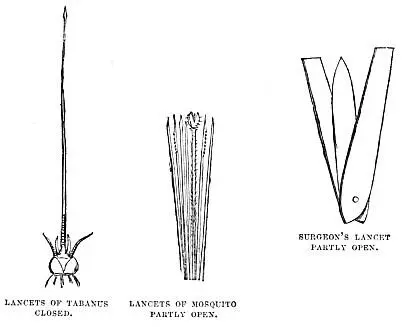John George Wood - Nature's Teachings
Здесь есть возможность читать онлайн «John George Wood - Nature's Teachings» — ознакомительный отрывок электронной книги совершенно бесплатно, а после прочтения отрывка купить полную версию. В некоторых случаях можно слушать аудио, скачать через торрент в формате fb2 и присутствует краткое содержание. Издательство: Иностранный паблик, Жанр: foreign_antique, Природа и животные, foreign_edu, на английском языке. Описание произведения, (предисловие) а так же отзывы посетителей доступны на портале библиотеки ЛибКат.
- Название:Nature's Teachings
- Автор:
- Издательство:Иностранный паблик
- Жанр:
- Год:неизвестен
- ISBN:нет данных
- Рейтинг книги:5 / 5. Голосов: 1
-
Избранное:Добавить в избранное
- Отзывы:
-
Ваша оценка:
- 100
- 1
- 2
- 3
- 4
- 5
Nature's Teachings: краткое содержание, описание и аннотация
Предлагаем к чтению аннотацию, описание, краткое содержание или предисловие (зависит от того, что написал сам автор книги «Nature's Teachings»). Если вы не нашли необходимую информацию о книге — напишите в комментариях, мы постараемся отыскать её.
Nature's Teachings — читать онлайн ознакомительный отрывок
Ниже представлен текст книги, разбитый по страницам. Система сохранения места последней прочитанной страницы, позволяет с удобством читать онлайн бесплатно книгу «Nature's Teachings», без необходимости каждый раз заново искать на чём Вы остановились. Поставьте закладку, и сможете в любой момент перейти на страницу, на которой закончили чтение.
Интервал:
Закладка:
I find some little difficulty in arranging the subject which comes next in order. It might very properly be ranked among the Levers, which will be treated of in another chapter; or it might be placed among the examples of centrifugal force, together with the sling, the “governor” of the steam-engine, &c., all of which will be more fully described in their places. However, as we are on the subject of Projectiles, we may as well take it in the present place.
It is the Throwing-stick, by which the power of the human arm is enormously increased, when a spear is to be hurled. Perhaps the most expert spear-throwers in the world are to be found among the Kafir tribes of Southern Africa, and yet the most experienced among them could not make sure of hitting a man at any distance above thirty or forty yards. But the throwing-stick gives nearly double the range, and I have seen the comparatively slight and feeble Australian hurl a spear to a distance of a hundred yards, and with an aim as perfect as that of a Kafir at one-fourth of the distance.
The mode in which this feat is performed is shown in the accompanying diagram. Instead of holding the spear itself, the native furnishes himself with a “Throwing-stick.” This weapon varies greatly in shape and size, but a very good idea of its form, and the manner of using it, may be obtained from the accompanying illustration, which was drawn from the actual specimen as held by an Australian native.
The throwing-stick is armed at the tip with a short spike, which fits into a little hole in the but of the spear. The stick and spear being then held as shown in the illustration, it is evident that a powerful leverage is obtained, varying according to the length of the stick. I possess several of these instruments, no two of which are alike.
It is rather remarkable that among the Esquimaux a throwing-stick is also used, exactly similar in principle, but differing slightly in structure, the but of the spear fitting into a hole at the end of the throwing-stick. Wood being scarce among the Esquimaux, these instruments are mostly made of bone. I possess one, however, which is made of wood, beautifully polished, and adorned with a large blue stone, something like a turquoise, set almost in its middle. One of the most curious points in the formation of the Esquimaux weapon is, that the but is grooved and channelled so as to admit the fingers and thumb of the right hand. The average length of this instrument is twenty inches.

In New Caledonia the natives use a contrivance for increasing the power of the spear, which is based on exactly identical principles, though the mode of carrying them out is different. A thong or cord of some eighteen inches in length is kept in the right hand, one end being looped over the forefinger, and the other, which is terminated by a button, being twisted round the shaft of the spear. When the weapon is thrown, the additional leverage gives it great power; and it is a noteworthy fact that the sling-spear of New Caledonia has enabled us to understand the otherwise unintelligible “amentum” of the ancient classic writers.
Passing from Art to Nature, we have in the jaw of the serpent an exact type of the peculiar leverage by which the spear is thrown. If the reader will refer to the illustration, he will see that the lower jaw of the snake, instead of being set directly on the upper jaw, is attached to an elongated bone, which gives the additional leverage which is needful in the act of swallowing prey, after the manner of serpents.
In War and in Peace we have been long accustomed to shield the edges and points of our sharp weapons with sheaths, and even the very savages have been driven to this device. I have in my collection a number of sheathed weapons from nearly all parts of the world, and it is a remarkable fact that the Fan tribe, who are themselves absolutely naked, sheathe their daggers and axes as carefully as we sheathe our swords and bayonets. In some points, indeed, they go beyond us; for the most ignorant Fan savage would never think of blunting the edge of his weapon by sheathing it in a metal scabbard. Their sheaths are beautifully made of two flat pieces of wood, just sufficiently hollowed to allow the blade to lie between them, and bound together with various substances. For example, the sheaths of one or two daggers in my possession are made of wood covered with snake-skin, while others are simply wood bound with a sort of rattan. Even the curious missile-axe which the Fan warrior uses with such power is covered with a sheath when not in actual use.
The figure on the right hand of the illustration represents the heads of two spears of Waganda warriors. When they present themselves before their king, the warriors must not appear without their weapons, and it would be contrary to all etiquette to show a bare blade except in action. The sheath can be slipped off in a moment, but there it is, and any man who dared to appear before his sovereign without his weapon, or with an unsheathed spear, would lose his life on the spot, so exact is the code of etiquette among these savages.
The sheathed spears of Nature are shown in the same illustration. On the left is a side view of the piercing apparatus of the common Gnat.
In the middle is the compound piercing apparatus of the common Flea, with which we are sometimes too well acquainted, the upper figure showing the lancets and sheaths together, and the lower exhibiting them when separated.
On the right is shown the group of mouth-lancets belonging to one of the Humble-bee flies ( Bombylius ). These flies do not suck blood like the Mosquito, the Flea, and the Gad-fly, but they use the long proboscis for sucking the sweet juices out of flowers, and in consequence it is nearly of the same form as if it were meant for sucking blood. Indeed, there are some insects which do not seem to care very much whether the juice which they suck is animal or vegetable.
On the right hand of the illustration is seen an Indian sword, or “Tulwar,” drawn from one of my own specimens. I have selected this example on account of the structure of the sheath. It is evident, from the form of the blade, that the sword cannot be sheathed point foremost, and that therefore some other plan must be used. In this weapon the sheath is left open on one side, the two portions being held together by the straps which are shown in the figure. Of course there is loss of time in sheathing and drawing such a sword, but the peculiar shape of the blade entails a necessity for a special scabbard.
On the other side is shown one of the fore-claws of a cat, which, as we all know, can be drawn back into its simple sheath between the toes, when it is not in use. This sheath is exactly the same in principle as that of the Indian tulwar, and any one can examine it by looking at the foot of a good-tempered cat. I have done so even with a chetah, which is not a subject that would generally be chosen for such a purpose.
On the next illustration is shown an ordinary Lancet, in which the blade is guarded between a double sheath, the two halves and the blade itself working upon a common pivot. As for the ordinary sword and dagger sheaths, it is not worth while to figure them.
Turning to the opposite side of the illustration, we shall see a few of the innumerable examples in which the principle of the sheath was carried out in Nature long before man came on the earth.
The reader should compare this figure with the side view of the Gnat’s lancets given on p. 81.

They represent the cutting and piercing instruments of several insects, all of which are very complicated, and are sheathed after the manner of the lancet. Indeed, they are popularly known as “mouth-lancets,” and with reason, as the reader may see by reference to the illustration.
Читать дальшеИнтервал:
Закладка:
Похожие книги на «Nature's Teachings»
Представляем Вашему вниманию похожие книги на «Nature's Teachings» списком для выбора. Мы отобрали схожую по названию и смыслу литературу в надежде предоставить читателям больше вариантов отыскать новые, интересные, ещё непрочитанные произведения.
Обсуждение, отзывы о книге «Nature's Teachings» и просто собственные мнения читателей. Оставьте ваши комментарии, напишите, что Вы думаете о произведении, его смысле или главных героях. Укажите что конкретно понравилось, а что нет, и почему Вы так считаете.












